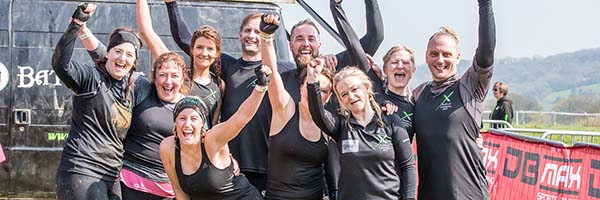As temperatures drop and winter approaches, many obstacle course race enthusiasts face a unique challenge: training for their next race in cold conditions. While some might prefer the warmth of the gym during the colder months, those looking to tackle an OCR in winter must adapt their training plan. So, let’s dive into the specifics of how to train for an OCR in winter:
1. Layer Up for Success
One of the first steps to training for a cold-weather obstacle course race is to wear the right kit. Dressing appropriately is crucial to stay warm, comfortable and safe during training sessions. Here are some key clothing considerations:
- Moisture-wicking base layers: Start with a moisture-wicking base layer to keep sweat away from your skin, helping you stay dry and warm
- Insulating layers: Depending on the temperature, add insulating layers like fleece or thermal shirts to trap heat
- Windproof and waterproof outer layers: Protect yourself from cold winds and rain with a windproof and waterproof jacket
- Gloves and hats: Don’t forget your extremities! Insulated gloves and a warm hat will help retain heat
- Compression clothing: Consider wearing compression clothing to improve blood circulation (it’ll also help reduce muscle soreness after training)
Read more about what to wear during a cold Obstacle Course Race.
2. Adjust Your Training Plan
Training for a cold-weather OCR is a little unique. Here’s how to switch-up your training plan:
- Warm-up thoroughly: In colder weather, your muscles may take longer to loosen up. Spend extra time warming up to prevent injury
- Indoor workouts: When conditions are too harsh to train outdoors, head indoors. Focus on strength training, flexibility and agility exercises to maintain your OCR skills
- Embrace the elements: If you plan to race in the cold, you’ll need to get some exposure to similar conditions. Head outdoors for at least some of your workouts to acclimatize to the cold and develop the mental toughness needed to succeed on race day
3. Prioritize Strength and Endurance
Cold weather will sap your energy more quickly than during summer months. Therefore, it’s crucial to build strength and endurance during your cold-weather training. Here’s how:
- Strength training: Incorporate strength exercises (which we cover in this blog) that target the muscle groups needed for obstacle courses. Focus on compound movements like squats, deadlifts and pull-ups to improve overall strength
- Endurance training: Cold air can affect your lung capacity, so prioritize cardio workouts that enhance your endurance. Running, cycling and swimming are excellent choices
- High-intensity interval training (HIIT): HIIT workouts can help you maintain your intensity and keep warm during training sessions. Mix short bursts of intense effort with brief recovery periods. More on that here.
4. Master Obstacle Techniques
Training for cold-weather OCRs is the perfect opportunity to work on your obstacle techniques and form. Here’s how to do it effectively:
- Simulate obstacles: If you can’t access actual obstacles during cold weather, create makeshift versions using gym equipment or outdoor structures like playgrounds. You can do a lot at home – here’s 5 superb home-based exercises
- Focus on grip strength: Many obstacles require a strong grip. Incorporate exercises like farmer’s walks, hanging from pull-up bars or using grip strength tools to improve your grip
- Practice under challenging conditions: When training outdoors, choose locations with varying terrain and incorporate mud and water elements to simulate race conditions
5. Fuel and Hydration
Proper nutrition and hydration are critical for cold-weather training. We talk more about nutrition in this blog post, but here’s the key considerations:
- Stay hydrated: It’s easy to underestimate your fluid needs in the cold, but dehydration can still occur. Drink water or sports drinks regularly, even if you don’t feel as thirsty as you would in hot weather
- Eat for energy: Cold weather can increase your calorie expenditure, so make sure you’re fueling adequately with a balanced diet that includes carbohydrates, protein and healthy fats
6. Mental Toughness
Finally, don’t underestimate the mental challenge of training and racing in cold weather. Here are some strategies to build mental toughness:
- Visualization: Use visualization techniques to imagine yourself overcoming obstacles and completing the race successfully, even in challenging conditions
- Positive self-talk: Replace negative thoughts with positive affirmations to boost your confidence and motivation
- Set realistic goals: Understand that your performance in the cold may not match your performance in ideal conditions, and that’s okay. Set achievable goals for your cold-weather races




